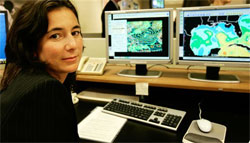
National Hurricane Preparedness Week
By Jonathan Berken

Michelle Mainelli is a new Hurricane Specialist appointed to work at the National Hurricane Center in Miami.
(Photo: ©J. Pat Carter/AP Wide World) May 23, 2006–This week is all about the weather. It’s National Hurricane Preparedness Week, sponsored by the National Oceanic and Atmospheric Administration (NOAA). Organizers hope that the event will increase awareness about the dangers of hurricanes and teach people steps that can be taken to minimize the devastation caused by powerful storms.
“Preparation through education is less costly than learning through tragedy,” said Max Mayfield, the director of the National Hurricane Center.
The NOAA recently released a report predicting an 80% chance of having another "above-normal" hurricane season. Just last fall, Hurricane Katrina destroyed a large portion of the Gulf Coast, making it one of the worst natural disasters to ever affect our country.
The NOAA’s predictions are based on calculations of the amount of energy in the atmosphere that can turn into storms. They call this calculation the Accumulated Cyclone Energy, or ACE index. According to their forecasts, the predicted ACE index this year might be twice what is normal. This means that there is an increased chance of bad weather this season. Fortunately, though, this year's hurricane season is not predicted to be quite as bad as last year, when there were 28 storms and 15 hurricanes.
In a normal season, there are typically about 11 named storms, and only 6 become hurricanes. This hurricane season, meteorologists (weather scientists) expect between 13-16 named storms in the Atlantic Ocean and 8-10 hurricanes. Of these hurricanes, 4-6 are predicted to be from Category 3 to Category 5, the severest storms possible (Hurricane Katrina was a Category 4 storm).
The conditions that favor significant storms include an above-normal sea-surface temperature, reduced atmospheric pressure at sea level, increased moisture across the tropical areas of the Atlantic Ocean, and certain types of wind patterns.
Hurricane season begins in June, with most storms forming between August and October. The forecast is intended not to frighten people, but to encourage those living in areas often hit by hurricanes to be better prepared. Better preparation can save both lives and property if another Katrina-like storm comes along.
|